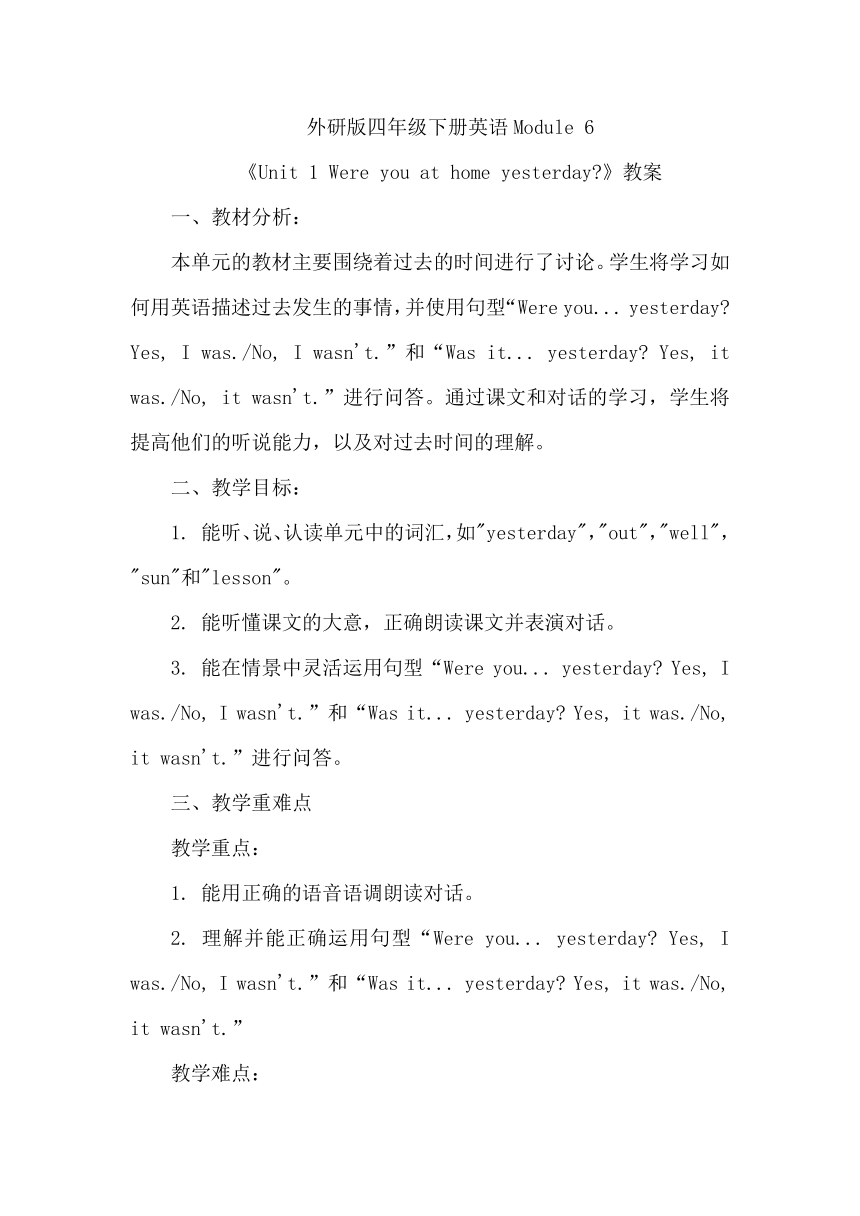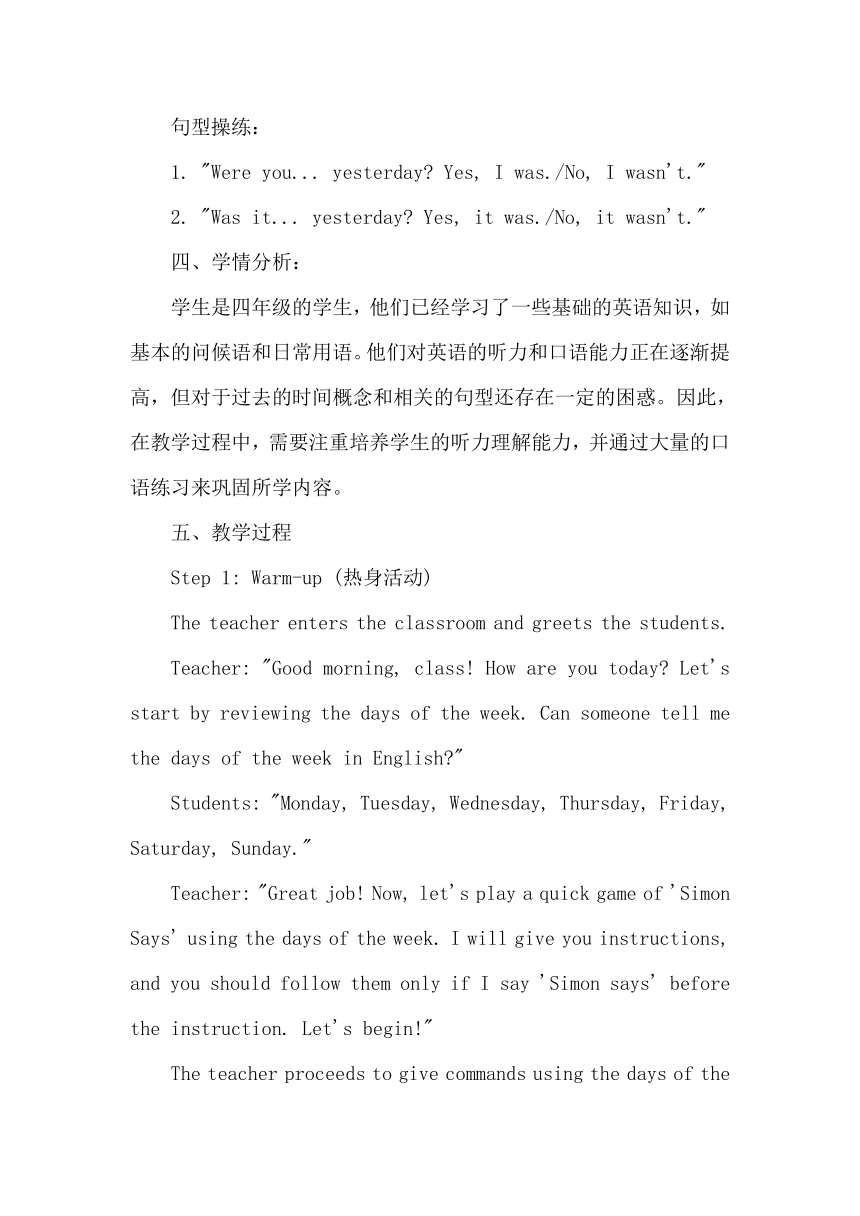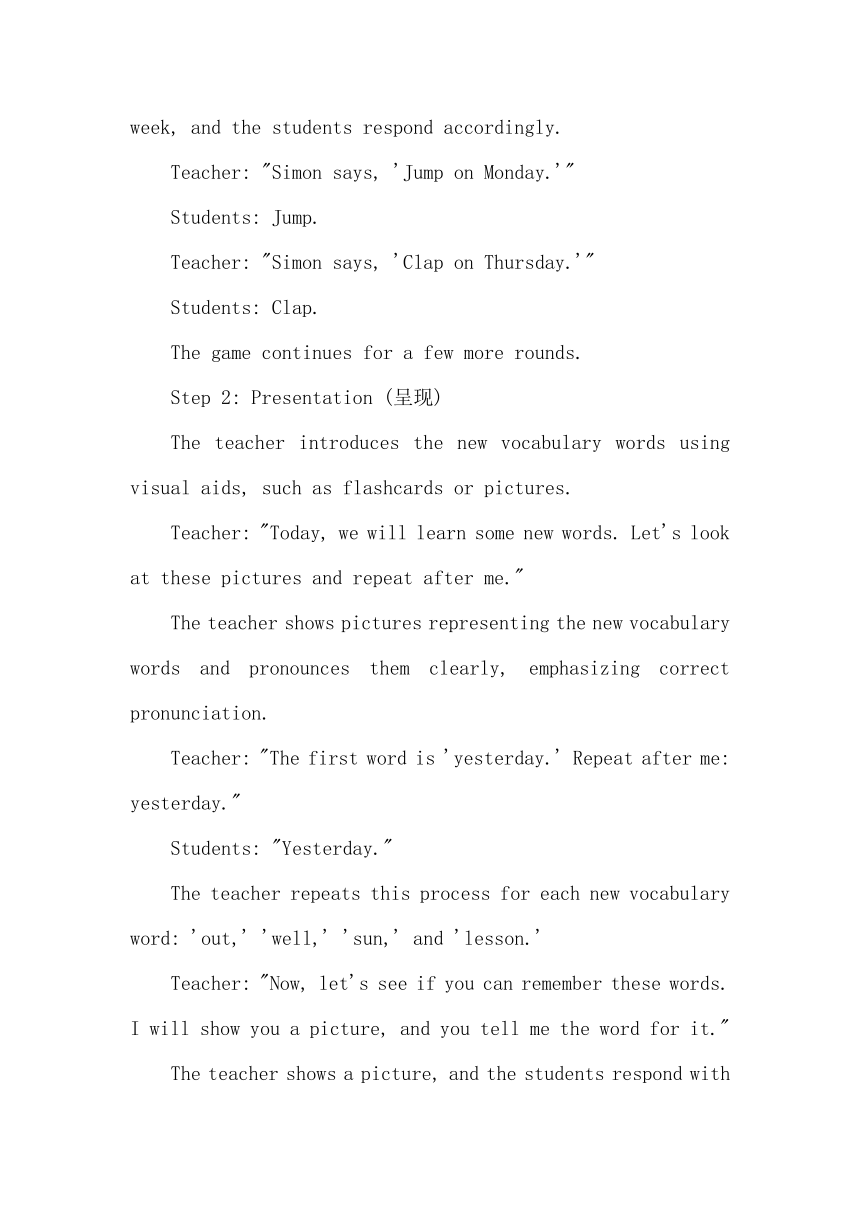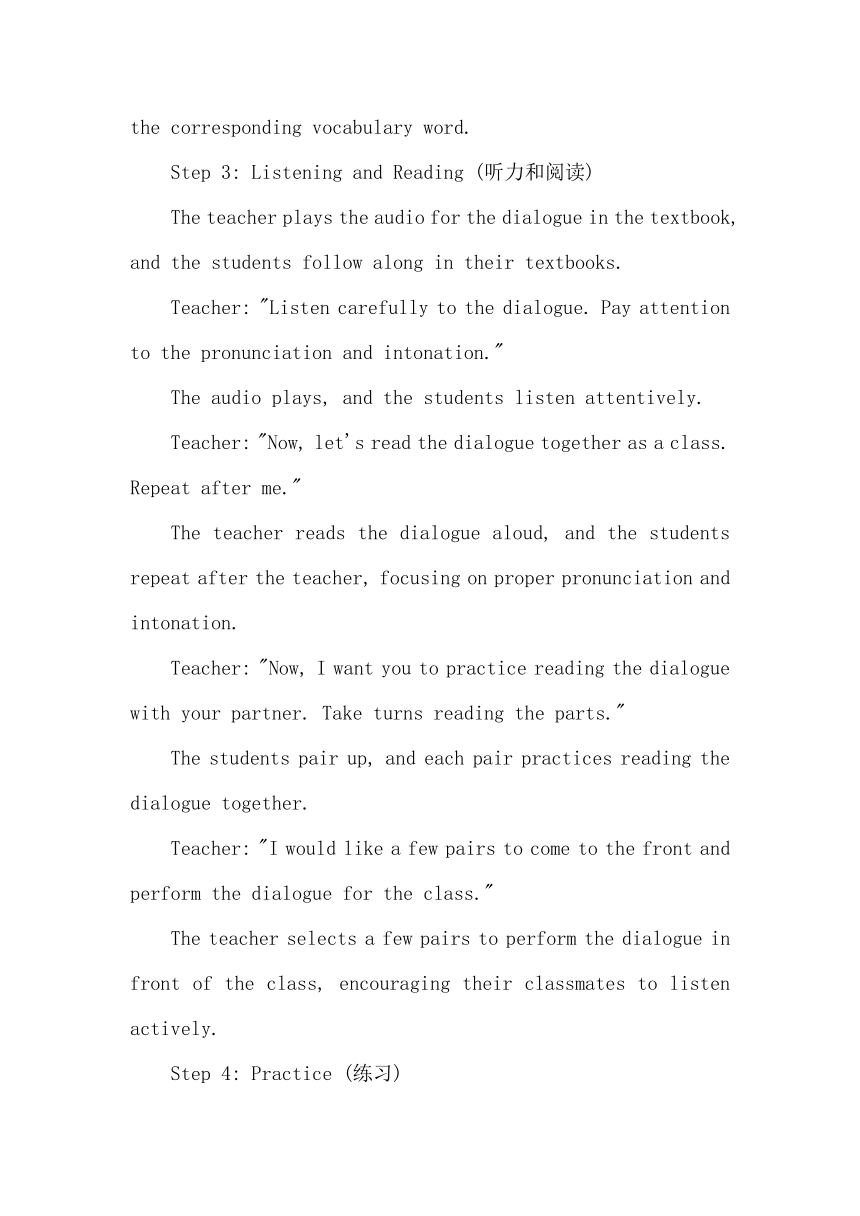Module 6 Unit 1 Were you at home yesterday?教案
文档属性
| 名称 | Module 6 Unit 1 Were you at home yesterday?教案 |

|
|
| 格式 | docx | ||
| 文件大小 | 15.4KB | ||
| 资源类型 | 教案 | ||
| 版本资源 | 外研版(三年级起点) | ||
| 科目 | 英语 | ||
| 更新时间 | 2024-03-12 08:08:00 | ||
图片预览




文档简介
外研版四年级下册英语Module 6
《Unit 1 Were you at home yesterday 》教案
一、教材分析:
本单元的教材主要围绕着过去的时间进行了讨论。学生将学习如何用英语描述过去发生的事情,并使用句型“Were you... yesterday Yes, I was./No, I wasn't.”和“Was it... yesterday Yes, it was./No, it wasn't.”进行问答。通过课文和对话的学习,学生将提高他们的听说能力,以及对过去时间的理解。
二、教学目标:
1. 能听、说、认读单元中的词汇,如"yesterday","out","well","sun"和"lesson"。
2. 能听懂课文的大意,正确朗读课文并表演对话。
3. 能在情景中灵活运用句型“Were you... yesterday Yes, I was./No, I wasn't.”和“Was it... yesterday Yes, it was./No, it wasn't.”进行问答。
教学重难点
教学重点:
1. 能用正确的语音语调朗读对话。
2. 理解并能正确运用句型“Were you... yesterday Yes, I was./No, I wasn't.”和“Was it... yesterday Yes, it was./No, it wasn't.”
教学难点:
句型操练:
1. "Were you... yesterday Yes, I was./No, I wasn't."
2. "Was it... yesterday Yes, it was./No, it wasn't."
四、学情分析:
学生是四年级的学生,他们已经学习了一些基础的英语知识,如基本的问候语和日常用语。他们对英语的听力和口语能力正在逐渐提高,但对于过去的时间概念和相关的句型还存在一定的困惑。因此,在教学过程中,需要注重培养学生的听力理解能力,并通过大量的口语练习来巩固所学内容。
五、教学过程
Step 1: Warm-up (热身活动)
The teacher enters the classroom and greets the students.
Teacher: "Good morning, class! How are you today Let's start by reviewing the days of the week. Can someone tell me the days of the week in English "
Students: "Monday, Tuesday, Wednesday, Thursday, Friday, Saturday, Sunday."
Teacher: "Great job! Now, let's play a quick game of 'Simon Says' using the days of the week. I will give you instructions, and you should follow them only if I say 'Simon says' before the instruction. Let's begin!"
The teacher proceeds to give commands using the days of the week, and the students respond accordingly.
Teacher: "Simon says, 'Jump on Monday.'"
Students: Jump.
Teacher: "Simon says, 'Clap on Thursday.'"
Students: Clap.
The game continues for a few more rounds.
Step 2: Presentation (呈现)
The teacher introduces the new vocabulary words using visual aids, such as flashcards or pictures.
Teacher: "Today, we will learn some new words. Let's look at these pictures and repeat after me."
The teacher shows pictures representing the new vocabulary words and pronounces them clearly, emphasizing correct pronunciation.
Teacher: "The first word is 'yesterday.' Repeat after me: yesterday."
Students: "Yesterday."
The teacher repeats this process for each new vocabulary word: 'out,' 'well,' 'sun,' and 'lesson.'
Teacher: "Now, let's see if you can remember these words. I will show you a picture, and you tell me the word for it."
The teacher shows a picture, and the students respond with the corresponding vocabulary word.
Step 3: Listening and Reading (听力和阅读)
The teacher plays the audio for the dialogue in the textbook, and the students follow along in their textbooks.
Teacher: "Listen carefully to the dialogue. Pay attention to the pronunciation and intonation."
The audio plays, and the students listen attentively.
Teacher: "Now, let's read the dialogue together as a class. Repeat after me."
The teacher reads the dialogue aloud, and the students repeat after the teacher, focusing on proper pronunciation and intonation.
Teacher: "Now, I want you to practice reading the dialogue with your partner. Take turns reading the parts."
The students pair up, and each pair practices reading the dialogue together.
Teacher: "I would like a few pairs to come to the front and perform the dialogue for the class."
The teacher selects a few pairs to perform the dialogue in front of the class, encouraging their classmates to listen actively.
Step 4: Practice (练习)
The teacher writes the sentence patterns on the board: "Were you... yesterday " and "Was it... yesterday "
Teacher: "These are the sentence patterns we will practice today. Let's start with a simple question and answer. Watch me."
The teacher models the question-answer patterns with a student.
Teacher: "Were you at home yesterday "
Student: "Yes, I was." / "No, I wasn't."
Teacher: "Was it sunny yesterday "
Student: "Yes, it was." / "No, it wasn't."
Teacher: "Now, I want you to practice with your partner. Ask and answer questions using these sentence patterns. Pay attention to your pronunciation and intonation."
The students pair up and take turns asking and answering questions using the sentence patterns. The teacher moves around the classroom, monitoring their pronunciation and providing feedback and guidance where needed.
Step 5: Role Play (角色扮演)
The teacher divides the class into pairs and assigns roles (A and B) for a role play activity.
Teacher: "Now, I will give each pair a different scenario to role play. Use the sentence patterns we just practiced. Partner A, ask Partner B if they were at the park yesterday. Partner B, answer A's question and ask A if it was sunny yesterday. Partner A, answer B's question."
The teacher gives each pair a moment to prepare their role play and then invites them to perform in front of the class.
Step 6: Consolidation (巩固)
The teacher reviews the vocabulary words and sentence patterns through an interactive game of "Guess the Word."
Teacher: "Let's play a game to review the vocabulary words. I will give you clues, and you need to guess the word. Are you ready "
The teacher provides clues for each vocabulary word, and the students try to guess the word.
Teacher: "I'm thinking of a word. It starts with the letter 'y' and means the day before today. What is it "
Students: "Yesterday!"
The game continues with the other vocabulary words.
After the game, the teacher initiates a class discussion using the sentence patterns.
Teacher: "Now, let's have adiscussion using the sentence patterns we learned. I will ask you some questions, and I want you to take turns answering them. Remember to use the correct sentence patterns."
The teacher asks questions related to the topic, such as:
Teacher: "Were you at home yesterday What did you do "
Students take turns answering the questions using the sentence patterns.
Step 7: Wrap-up (总结)
The teacher concludes the lesson by summarizing the key points and vocabulary words.
Teacher: "Today, we learned about the days of the week, new vocabulary words, and how to ask and answer questions using the past tense. Remember to practice these sentence patterns and review the vocabulary words."
The teacher assigns homework related to the lesson's objectives, such as practicing the sentence patterns or reviewing the vocabulary words.
Teacher: "For homework, I would like you to practice using the sentence patterns we learned today. You can ask and answer questions with a family member or friend. Also, review the vocabulary words we discussed. Have a great day!"
六、板书设计:
Vocabulary:yesterday;out;well;sun;lesson
Sentence Patterns:
Were you... yesterday Yes, I was. / No, I wasn't.
Was it... yesterday Yes, it was. / No, it wasn't.
七、教学反思:
本节课主要围绕过去的时间展开,通过听说的练习帮助学生掌握描述过去事件的句型,并且通过角色扮演和问答训练帮助学生在情景中灵活运用所学内容。在教学过程中,学生参与度较高,他们积极回答问题并尝试用英语进行交流。然而,一些学生在句型的正确运用上仍然存在一些困难,需要进一步练习和巩固。在今后的教学中,可以加入更多的口语练习和游戏,以提高学生的语言表达能力和自信心。
《Unit 1 Were you at home yesterday 》教案
一、教材分析:
本单元的教材主要围绕着过去的时间进行了讨论。学生将学习如何用英语描述过去发生的事情,并使用句型“Were you... yesterday Yes, I was./No, I wasn't.”和“Was it... yesterday Yes, it was./No, it wasn't.”进行问答。通过课文和对话的学习,学生将提高他们的听说能力,以及对过去时间的理解。
二、教学目标:
1. 能听、说、认读单元中的词汇,如"yesterday","out","well","sun"和"lesson"。
2. 能听懂课文的大意,正确朗读课文并表演对话。
3. 能在情景中灵活运用句型“Were you... yesterday Yes, I was./No, I wasn't.”和“Was it... yesterday Yes, it was./No, it wasn't.”进行问答。
教学重难点
教学重点:
1. 能用正确的语音语调朗读对话。
2. 理解并能正确运用句型“Were you... yesterday Yes, I was./No, I wasn't.”和“Was it... yesterday Yes, it was./No, it wasn't.”
教学难点:
句型操练:
1. "Were you... yesterday Yes, I was./No, I wasn't."
2. "Was it... yesterday Yes, it was./No, it wasn't."
四、学情分析:
学生是四年级的学生,他们已经学习了一些基础的英语知识,如基本的问候语和日常用语。他们对英语的听力和口语能力正在逐渐提高,但对于过去的时间概念和相关的句型还存在一定的困惑。因此,在教学过程中,需要注重培养学生的听力理解能力,并通过大量的口语练习来巩固所学内容。
五、教学过程
Step 1: Warm-up (热身活动)
The teacher enters the classroom and greets the students.
Teacher: "Good morning, class! How are you today Let's start by reviewing the days of the week. Can someone tell me the days of the week in English "
Students: "Monday, Tuesday, Wednesday, Thursday, Friday, Saturday, Sunday."
Teacher: "Great job! Now, let's play a quick game of 'Simon Says' using the days of the week. I will give you instructions, and you should follow them only if I say 'Simon says' before the instruction. Let's begin!"
The teacher proceeds to give commands using the days of the week, and the students respond accordingly.
Teacher: "Simon says, 'Jump on Monday.'"
Students: Jump.
Teacher: "Simon says, 'Clap on Thursday.'"
Students: Clap.
The game continues for a few more rounds.
Step 2: Presentation (呈现)
The teacher introduces the new vocabulary words using visual aids, such as flashcards or pictures.
Teacher: "Today, we will learn some new words. Let's look at these pictures and repeat after me."
The teacher shows pictures representing the new vocabulary words and pronounces them clearly, emphasizing correct pronunciation.
Teacher: "The first word is 'yesterday.' Repeat after me: yesterday."
Students: "Yesterday."
The teacher repeats this process for each new vocabulary word: 'out,' 'well,' 'sun,' and 'lesson.'
Teacher: "Now, let's see if you can remember these words. I will show you a picture, and you tell me the word for it."
The teacher shows a picture, and the students respond with the corresponding vocabulary word.
Step 3: Listening and Reading (听力和阅读)
The teacher plays the audio for the dialogue in the textbook, and the students follow along in their textbooks.
Teacher: "Listen carefully to the dialogue. Pay attention to the pronunciation and intonation."
The audio plays, and the students listen attentively.
Teacher: "Now, let's read the dialogue together as a class. Repeat after me."
The teacher reads the dialogue aloud, and the students repeat after the teacher, focusing on proper pronunciation and intonation.
Teacher: "Now, I want you to practice reading the dialogue with your partner. Take turns reading the parts."
The students pair up, and each pair practices reading the dialogue together.
Teacher: "I would like a few pairs to come to the front and perform the dialogue for the class."
The teacher selects a few pairs to perform the dialogue in front of the class, encouraging their classmates to listen actively.
Step 4: Practice (练习)
The teacher writes the sentence patterns on the board: "Were you... yesterday " and "Was it... yesterday "
Teacher: "These are the sentence patterns we will practice today. Let's start with a simple question and answer. Watch me."
The teacher models the question-answer patterns with a student.
Teacher: "Were you at home yesterday "
Student: "Yes, I was." / "No, I wasn't."
Teacher: "Was it sunny yesterday "
Student: "Yes, it was." / "No, it wasn't."
Teacher: "Now, I want you to practice with your partner. Ask and answer questions using these sentence patterns. Pay attention to your pronunciation and intonation."
The students pair up and take turns asking and answering questions using the sentence patterns. The teacher moves around the classroom, monitoring their pronunciation and providing feedback and guidance where needed.
Step 5: Role Play (角色扮演)
The teacher divides the class into pairs and assigns roles (A and B) for a role play activity.
Teacher: "Now, I will give each pair a different scenario to role play. Use the sentence patterns we just practiced. Partner A, ask Partner B if they were at the park yesterday. Partner B, answer A's question and ask A if it was sunny yesterday. Partner A, answer B's question."
The teacher gives each pair a moment to prepare their role play and then invites them to perform in front of the class.
Step 6: Consolidation (巩固)
The teacher reviews the vocabulary words and sentence patterns through an interactive game of "Guess the Word."
Teacher: "Let's play a game to review the vocabulary words. I will give you clues, and you need to guess the word. Are you ready "
The teacher provides clues for each vocabulary word, and the students try to guess the word.
Teacher: "I'm thinking of a word. It starts with the letter 'y' and means the day before today. What is it "
Students: "Yesterday!"
The game continues with the other vocabulary words.
After the game, the teacher initiates a class discussion using the sentence patterns.
Teacher: "Now, let's have adiscussion using the sentence patterns we learned. I will ask you some questions, and I want you to take turns answering them. Remember to use the correct sentence patterns."
The teacher asks questions related to the topic, such as:
Teacher: "Were you at home yesterday What did you do "
Students take turns answering the questions using the sentence patterns.
Step 7: Wrap-up (总结)
The teacher concludes the lesson by summarizing the key points and vocabulary words.
Teacher: "Today, we learned about the days of the week, new vocabulary words, and how to ask and answer questions using the past tense. Remember to practice these sentence patterns and review the vocabulary words."
The teacher assigns homework related to the lesson's objectives, such as practicing the sentence patterns or reviewing the vocabulary words.
Teacher: "For homework, I would like you to practice using the sentence patterns we learned today. You can ask and answer questions with a family member or friend. Also, review the vocabulary words we discussed. Have a great day!"
六、板书设计:
Vocabulary:yesterday;out;well;sun;lesson
Sentence Patterns:
Were you... yesterday Yes, I was. / No, I wasn't.
Was it... yesterday Yes, it was. / No, it wasn't.
七、教学反思:
本节课主要围绕过去的时间展开,通过听说的练习帮助学生掌握描述过去事件的句型,并且通过角色扮演和问答训练帮助学生在情景中灵活运用所学内容。在教学过程中,学生参与度较高,他们积极回答问题并尝试用英语进行交流。然而,一些学生在句型的正确运用上仍然存在一些困难,需要进一步练习和巩固。在今后的教学中,可以加入更多的口语练习和游戏,以提高学生的语言表达能力和自信心。
同课章节目录
- Module 1
- Unit 1 She's a nice teache
- Unit 2 He's cool.
- Module 2
- Unit 1 London is a big city.
- Unit 2 It's very old.
- Module 3
- Unit 1 Robots will do everything.
- Unit 2 On Monday I'll go swimming.
- Module 4
- Unit 1 Will you take your kite?
- Unit 2 Will it be hot in Haikou?
- Module 5
- Unit 1 I was two then.
- Unit 2 They were young.
- Module 6
- Unit 1 Were you at home yesterday?
- Unit 2 Was it a big city then ?
- Module 7
- Unit 1 I helped Mum.
- Unit 2 Grandma cooked fish.
- Module 8
- Unit 1 They sang beautifully.
- Unit 2 I took some pictures.
- Module 9
- Unit 1 Did he live in New York ?
- Unit 2 Did you have a nice holiday?
- Review Module
- Unit 1
- Unit 2
- Module 10
- Unit 1 Did you fall off your bike?
- Unit 2 Sam had lots of chocolate.
